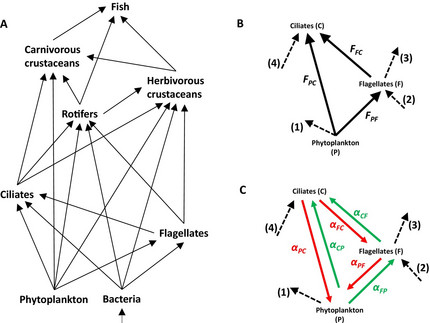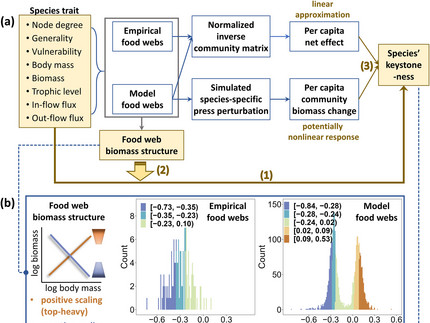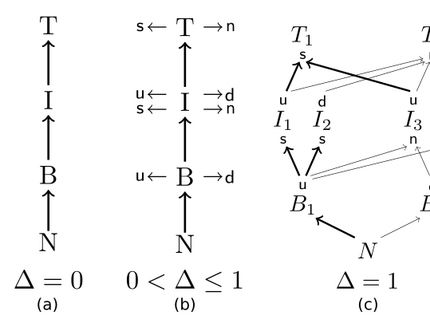Structure, stability and functioning of food webs
Contact persons: Dr. Christian Guill
1. Effects of temporal variability of spatial networks on meta-community food-web stability and diversity
This project investigates the structure and stability of complex food webs on a spatial network of habitat patches. We focus on temporal variability of the spatial network structure and its effects on biodiversity and population stability on local and regional scales. The spatial networks consist of isolated habitat patches that are embedded in a landscape. The links of the spatial networks are created by the species' abilities to disperse between habitat patches over varying distances. The availability of patches as habitat for a local community as well as the accessibility of dispersal routes changes over time, thereby changing the structure of the spatial networks.
In this project, computer-generated trophic and spatial networks are analysed. The population dynamics of the species are simulated with mathematical models based on ordinary differential equations. The survival of a species in a certain habitat depends on the availability of resources and the mortality through predation (and thus on the composition of the local community). Furthermore, its survival on the regional level depends on the ability to disperse over the landscape and colonise suitable habitat patches. We address different aspect of temporal variability of spatial networks, e.g. periodically blinking links (dispersal routes), not permanently available patches or variable environmental conditions.
This project is part of the DFG research group "Networks on Networks: The interplay of structure and dynamics in spatial ecological networks". Collaboration partners: Barbara Drossel, Ulrich Brose, Björn Rall, Bernd Blasius, Thilo Gross.
2. Keystone species - what determines how important they are?
Keystone species are defined by having a disproportionately large effect on the community when their abundances change in response to a perturbation (e.g., direct exploitation, habitat loss, or changing climatic conditions). This makes them an important target for conservation efforts and ecosystem management. Being able to reliably identify keystone species is thus clearly important, yet there are conflicting results on the species' traits (e.g., how well connected they are to the rest of the food web) that determine their keystone-ness.
We use a large data set of 144 empirical food webs that provides estimates of species' average biomasses and quantitative mass-balanced fluxes between them to calculate linear approximations of the net effects species have on each other and we complement this data with direct simulations of the non-linear population dynamics of model-generated food webs. This allows us to assess species' keystone-ness with two independent methods and to expand the range of scaling between species' body mass and biomass (i.e., how bottom-heavy or top-heavy the biomass distribution in a food web is). A key finding is that the relationships between species' energetic or structural traits and their keystone-ness are highly context dependent and may even be opposite in food webs with bottom-heavy or top-heavy biomass distribution.
This study was recently publised in Ecology Letters [link to study].
3. Trait adaptability and the stability and functioning of food webs
Functional traits of species that determine their interactions with others, e.g. defensive strategies or specialised offensive capabilities, are not static but can change over time by various mechanisms, ranging from phenotypic plasticity to evolutionary adaptation. Using small food webs with up to three trophic levels we have shown that functional diversity, especially at the level of the top predators, enables adaptive and compensatory dynamics throughout the food web that allows for efficient biomass transfer along the food chains (study 1, study 2). Furthermore, evolution of a single species in response to a perturbation overwhelmingly affects the survival of other species, with both positive indirect effects (evolutionary rescue) and negative indirect effects (evolutionary murder) being far more frequent than the corresponding self-effects (study 3). It remains, however, unclear how these observations scale up to large, complex food webs with realistic structure.



